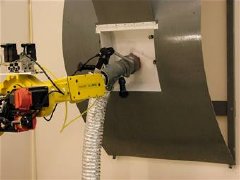Jan 12 2009
Air Force Research Laboratory's Materials and Manufacturing Directorate officials here are developing an automated aircraft refueling system for the F-35 Joint Strike Fighter.
 Air Force Research Laboratory researchers are developing a robot for automated aircraft ground refueling at Wright-Patterson Air Force Base, Ohio. In this photo, Air Force Research Laboratory's automated aircraft ground refueling system mock-up simulates performing a refueling test. (Courtesty photo)
Air Force Research Laboratory researchers are developing a robot for automated aircraft ground refueling at Wright-Patterson Air Force Base, Ohio. In this photo, Air Force Research Laboratory's automated aircraft ground refueling system mock-up simulates performing a refueling test. (Courtesty photo)
Successful development and testing of the system will provide a feasible alternative to manual refueling of aircraft.
The system will meet the goal of Air Force Smart Operations for the 21st century -- to find innovative ways to use Air Force materiel and personnel more efficiently. The decreased number of personnel near each aircraft during "hot" refueling -- refueling while one or more of the engines are operating -- will improve safety. Future advances based on the results of the system will allow refueling crews to operate free of Mission-Oriented Protective Posture gear in a closed environment and still be protected from chemical-biological risks.
Aircraft ground refueling equipment has improved but the method of refueling has changed minimally, said Walt Waltz, the robotic group lead.
"It is still a manual process that involves personnel handling the fuel supply hose, attaching, and then detaching it," Mr. Waltz said.
Researchers at the directorate's Airbase Technologies Division, located at Tyndall Air Force Base, Fla., received a request from officials at the Air Education and Training Command, the Air Force Petroleum Agency and the Naval Air Systems Command to develop an automated system to refuel the F-35 while on the ground. Mr. Waltz said that after considering several options, the researchers began developing a robot to meet this challenge.
Once completed, an operator will use this robotic system to initiate refueling with the push of a button on an operational control unit from several hundred feet away. The unit will communicate with a computer that will govern the robot's actions.
The robot will be tethered to a fuel hydrant by a pantograph. This multijointed, moving pipeline will follow behind the robot and supply it with fuel. A vision-based guidance system will direct the robot's movements. Vision and proximity sensors will observe the aircraft's location and the robot's approach path. The guidance system will confirm the aircraft type, assess its orientation, and locate the fuel door. The robot will then position itself near the fuel door. Once in position, accurate angular measurements will align the nozzle with the single point refueling adapter on the aircraft. The robot will attach the fuel nozzle and begin fueling. At completion, a similar reverse procedure will detach and retract the robot from the aircraft.
Throughout the refueling process, the guidance sensors will monitor unexpected changes in proximity to the aircraft or objects on the ground to prevent unwanted contact. The system's operator will use the operational control unit to monitor the simultaneous activities of one or more robots. A quick safety abort function will halt the system should a problem arise.
A recent demonstration was run using a vision-guided robot to move a refueling nozzle to an aircraft mock-up, locate the single point refueling adapter, and place a refueling nozzle on the adapter, Mr. Waltz said.
"A robotic arm was fitted with a charge-coupled device camera and a simulated (single point refueling) nozzle," he said. "A personal computer aided by a mainframe computer processed image files from the robot and guided it toward the single point refueling adapter. The robot slid the simulated nozzle around the adapter and rotated the nozzle. The process was demonstrated several times. The system's performance during the demonstration helped to prove that an autonomous robot is a feasible alternative to manual refueling."
The researchers are now making technology selections, evaluating robotic vision equipment, planning for the utilities required at the demonstration site and preparing to build the system. They plan to start demonstrational testing in 2010.